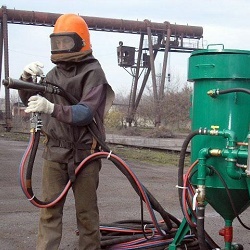All about trimmer fuel mix
Any owner of a country site had to deal with the task of mowing. The power saw is sometimes needed more often than a chainsaw or walker, because the grass grows faster than trees and shrubs. In this regard, the inevitable question arises, what kind of fuel mixture to fill in the trimmer? The mixture of gasoline and oil must be prepared in the correct proportion to ensure high engine performance. Below we will consider the possible consequences that may be caused by too rich or, on the contrary, too poor benzomixes in the trimmer. But first of all, it is necessary to understand the role that the oil for two-stroke engines plays, which most often equip gas trimmers.
Content
Lubricant Classification
The main difference between the principles of operation of a two-and four-stroke internal combustion engine (ICE) is that in the case of a 4-stroke unit the lubrication of the rubbing parts occurs with the help of the crankcase and the oil pump. The power of the four-stroke engine allows this unit to work. A trimmer with a two-stroke engine requires a mixture of gasoline and oil to lubricate the entire system (cylinder and pistons, crankshaft, bearing bearings). To properly dilute and prepare such a mixture for the trimmer, there is a special classification, often presented in the form of a table.
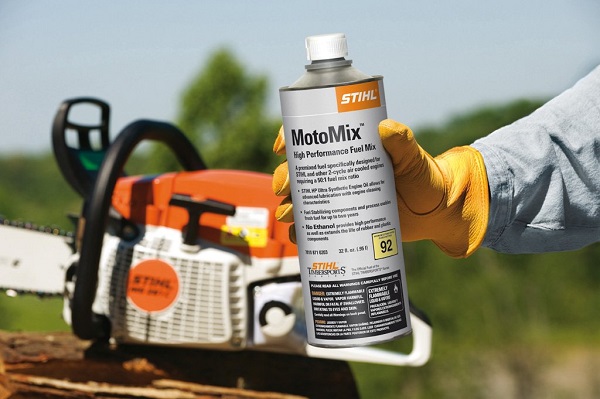
American
The oil in the trimmer is no different from lubricants intended for other garden and garden equipment, equipped with a two-stroke engine. It has the same composition, additive package and detergent properties. Let us consider in more detail the American classification of oils, or, as it is called, API.
- TA Group Designed for use in trimmers and mopeds with air-cooled two-stroke engine. The declared volume of devices is from 50 cc to 200 cc.
- TV group It is also used in trimmers and other garden equipment, only with an already increased engine capacity.
It must be remembered that TA and TV groups are not interchangeable, the ratio of gasoline and oil in them may differ.
Japanese
The classification of oils also exists in the Japanese. In contrast to the generally accepted American classification of the world, the Japanese are designed mainly for environmental standards.
- Group FA designed for use in trimmers and other devices for countries where exhaust emission rates are rather low.
- FB group intended for two-stroke trimmers, where the legislative requirements for exhaust are significantly increased.
- FC Group for trimmers, where the requirements for the development of gasoline and oil are minimal - zero exhaust.
The remaining classifications are not intended for trimmers.
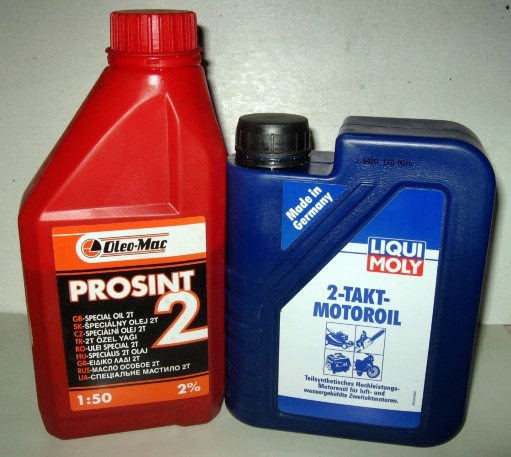
Oil requirements
The mixture of gasoline and oil chosen for the mowers must meet the necessary requirements specified in the instructions. It is important to note that domestic manufacturers often label their products a little differently, not in the way that is customary in the American or Japanese classification. Russian manufacturers of lubricants, as a rule, put a 2T label on all oils intended for two-stroke engines. Often on the shelves of stores you can find oil cans with marks on them. "Self mix" or "pre mix". In the first case, this means that the oil does not require any additional manipulations, it is enough just to pour gasoline and oil in one container, and mixing will occur without human intervention. In the second case, respectively, it is necessary to shake or shake the mixture to bring it to the desired consistency.
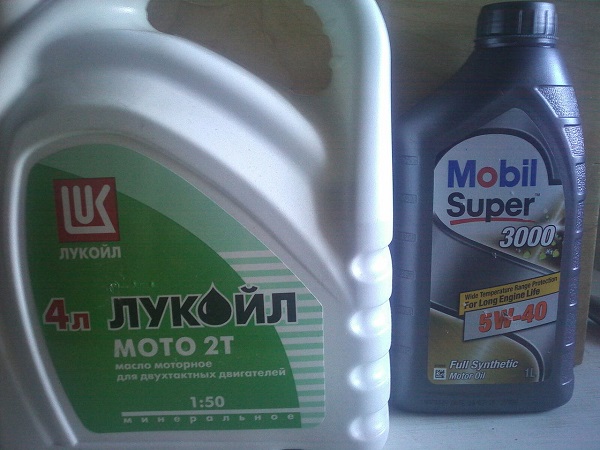
As you can see, the existence of various classifications of lubricants suggests that the use of oils in two-stroke engines is necessary. This is due to the fact that the fuel mixture without lubricant will quickly disable the internal combustion engine, which will not be lubricated properly. Gasoline and oil form the necessary environment, which reduces detonation, removes excess debris (working off generated from the combustion of gasoline products) and protects the internal surface of the engine from wear.
It is important to remember that when using the wrong classification oil may occur. motor breakage or clogging. Of course, it can be repaired, but in order to prevent possible failures, and to minimize their probability, it would be better to study the operating instructions, find out the volume of the two-stroke engine installed on the motokose, and use only gasoline and oil, which will be suitable for all parameters models.
Quite often in the recommendations section (and sometimes on the label), the manufacturer indicates the partner companies whose gasoline and oil he recommends pouring into his models. Most often, the fuel and lubricant recommended by the manufacturer will work best for the trimmer.
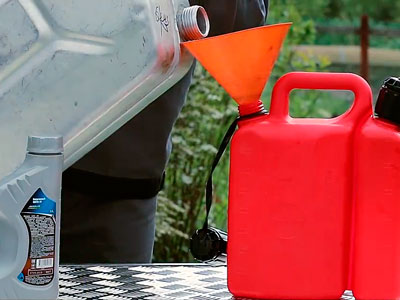
First of all, you should immediately exclude from the list of actively operated lubricants all oils of unknown (garage, basement) origin. It is usually difficult to dilute such oils because of the unclear basis, composition. As a rule, labels of unbranded manufacturers are not replete with information, covering only general information without clarification. It is not recommended to dilute and dilute oils such as AS-10 and ASZp-10. The origin of these lubricants is usually very vague, it is better to give preference to proven brands that are used every day by thousands of people across the country.
A distinctive feature of all oils for two-stroke engines is the fact that manufacturers paint them in a color that contrasts with gasoline. The liquid is translucent, viscous in consistency, slightly yellowish, but not thick. Usually, we are talking about three colors - red, green and blue.
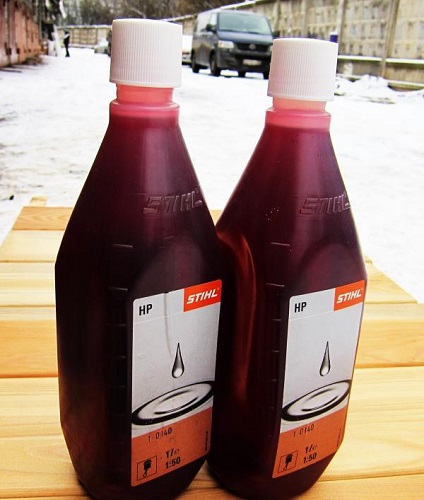
Do not forget that the color scheme does not affect the classification (as is often done in the case of antifreeze).
In no case can not use oil from the line, not intended for trimmer. This can adversely affect the operation of the power unit, lead to increased fuel consumption, soot on candles and a number of other problems that will have to be identified and fixed. It should be noted that if the fact of using oil that is not included in the tolerances is established, the seller has the full right to remove the unit from the warranty. This means that it will be necessary to carry out the replacement of the failed parts at our own expense, and no exceptions will help here.
If the acquired liquid does not have the stated qualities (for example, too liquid), in no case should you mix it with gasoline.It would be best to return this oil back to the store, explaining to the seller the reason for the return.
Gasoline for mixture preparation
Requirements for gasoline for the preparation of the mixture are extremely high, because he is its foundation. The first thing that should not be done is to look for places where you can buy cheaper fuel (refueling without a name, etc.), because in the end, all the seeming savings of several dozen rubles can be eaten by expensive engine repair, which is disabled by low-quality fuel.

Using cheap gasoline with a lower octane number, the user thereby increases the load on the unit. Its wear is much faster, the resource is reduced, and, in proportion not one to one, but much more
The second thing to remember is that it is important to use for the base mix. only fresh gasoline. Many in the country or in the garage have reserves of fuel that stand there for six months, waiting in the wings. The fuel, evaporating, enters into a chemical reaction with the surface of the canister (especially plastic), thereby acquiring new properties that are not at all useful for ICE. If gasoline has stood in the canister for a month and a half, it is better to pour it into the fuel tank, where, mixing with the total amount of more recent gasoline, it will not cause any harm to the engine of the car.Two-stroke ICEs are more sensitive in this regard. That is why manufacturers recommend using only the highest quality fuel.
As for the octane number, then there are disputes among specialists, which kind of gasoline to fill in with a trimmer, still do not calm down. Most manufacturers recommend that only high-octane gasoline of the 92nd brand be poured into the fuel system. True, there is one small caveat, quite often in the instructions the statement “not below 92nd” is indicated, and this leaves room for speculations as to which gasoline to use.

Of course, the performance (efficiency) of the 95th gasoline is slightly higher than that of the 92nd. The latter, in turn, is the heir of the Soviet 80th, which employed a lot of equipment. But with higher energy efficiency, the 95th is fraught with some features. For example, it is more suitable for modern car modelsWhile the internal combustion engines installed in garden equipment are far from some constructive innovations, their structure has remained almost unchanged for decades. For a two-stroke gasoline engine installed in most modern trimmers, it will be enough to fill in 92-nd brand gasoline purchased on a proven refueling network.
It is best to look for options without additives labeled "eco", "ecto", because For accurate work, you need a clean gasoline base. Additive mixture will provide oil.
Whether 95 petrol is needed for optimal performance, the question is rather philosophical, and there is no concrete answer for it. It is enough to remember that it is quite rare in tolerances and recommendations, and this already says a lot. In addition, it is poured, usually at your own peril and risk, wishing to improve performance. If for the sake of experiment you want to change the 92nd gasoline to the 95th, it is important to remember the consequences in the form of increased wear, unstable operation of the power unit and failure of its individual components. Of course, none of the above can happen, but the probability, in case of going beyond the tolerances, is extremely increasing.
Getting a mixture
How much oil to pour per liter, to get a quality gasoline mixture? It would seem that there is nothing difficult to mix the two substances. The preparation of the mixture is often complicated by the fact that different sources indicate different information. For example, the instruction indicates the proportion of 1 to 40, on the trimmer fuel tank 1 in 25, and on the canister with oil 1 in 50.
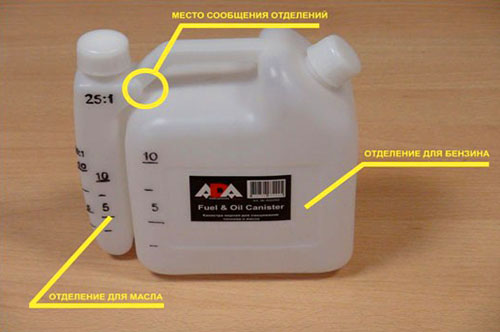
Most experts believe that you need to mix in accordance with the instructions indicated on the package with oil.
There are a number of requirements for how to dilute. Do not add too much oil. This leads to a decrease in the characteristics of ignition. The result is that the devaluation of the efficiency of the power unit, and the overall reduction of its resource. In the event of a gasoline mixture being oversaturated with oil, soot deposits (cylinder ventilation windows) will form on the inner surface of the engine walls. It is fraught with the formation of a badass on the piston.

Neither oil starvation nor excess lubricant in a gasoline base is a good basis for long-term operation of the internal combustion engine. For trouble-free continuous operation, the same number of components is required. Breeding is best done using the same dimensional tools to eliminate unnecessary errors.
How to calculate, say, how much to pour oil on 1 l of gasoline with the required ratio of 1 to 50? To do this, we translate the volume of gasoline in milliliters 1l = 1000 ml. Accordingly, to achieve a ratio of 1 to 50 thousand divided by fifty.On one liter of gasoline will need only 20 g of oil. Someone measures the oil with a 20 cubic meter syringe, but for such purposes there is special measuring spoonwhich sometimes comes complete with oil from some manufacturers.
Some important nuances
It is important to remember that you can not store the mixture for a long time. The storage itself is carried out only in a dark cool room without direct sunlight. Even if you intend to leave the mixture for several days before using it, you should put the canister on the ground to remove the effect of electrification. The container for the mixture should be only iron storage in plastic is not allowed.
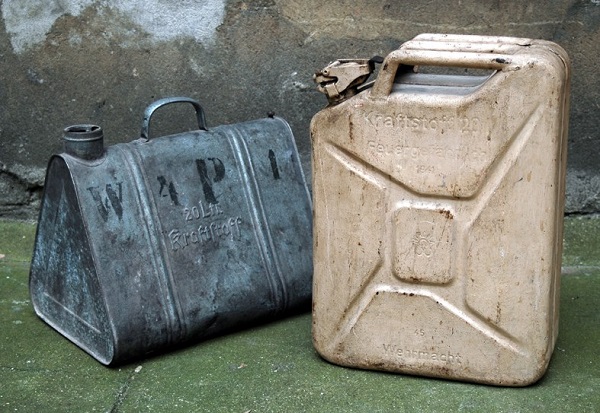
In no case can not be used to store gasoline and oils capacity from under the drinks (water, juice or lemonade). The basis of polyethylene terephthalate, on which the bottle for food is based, is not resistant to petroleum products and additives included in them.
In a properly prepared mixture lies the key to the correct operation of the engine throughout the life of the device. If done correctly, the flow rate will be low and the performance is high.It is a pleasure to work with such a trimmer. To pleasant emotions lasted as long as possible, you should automate the process of preparing and replacing the mixture and use the same resources (oil, fuel).
Mixing ingredients should not be carried out in the open air when exposed to direct sunlight.
Many brands today have abandoned such a thing as “running in” or working the first few mowings in a “sparing” mode, at low revs. In particular, the manufacturer of the benzocos Huskvarna recommends using the motokosa with all its power already from the first mowing, having previously given it to idle for 1-3 minutes. The main thing is that the prepared mixture has all the characteristics that are necessary for smooth lubrication and operation of the internal combustion engine.
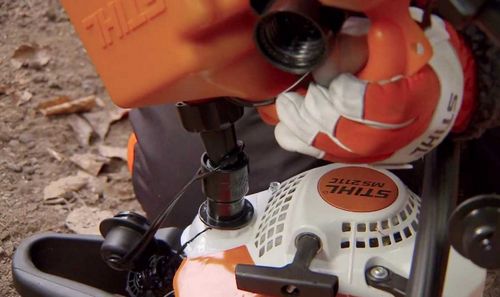
Conclusion
Preparation of the mixture for the trimmer fuel system is one of the most important tasks for its proper functioning. From the above, we can conclude that making a mixture with your own hands is not difficult, the main thing is to follow simple and clear recommendations. For the convenience of calculating the optimal proportion, it is best to refer to the table above.It lists all the most popular ratios of oil to gasoline.

/rating_off.png)








